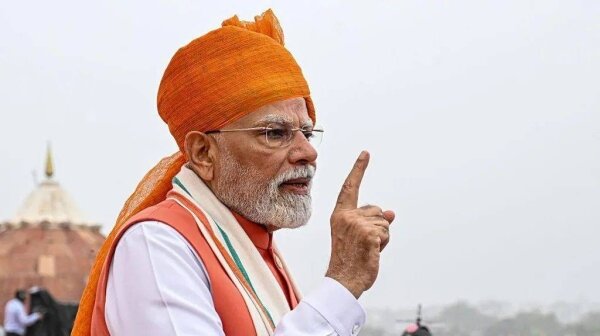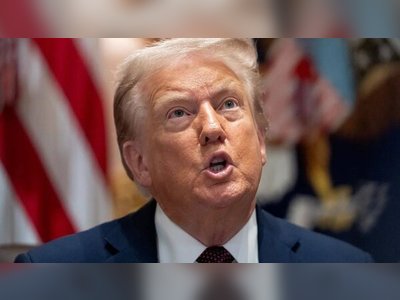
Modi Promotes Self-Reliance as Trump Imposes 50% Tariffs on India
Indian Prime Minister Narendra Modi urges self-reliance and tax cuts to mitigate the economic impact of US tariffs.
Donald Trump's steep 50% tariffs on India have taken effect, following an executive order imposing additional penalties over Russian oil and weapons purchases.
This move has placed India among the countries subject to the highest tariffs globally, potentially harming exports and growth in the world's fifth-largest economy.
The US was previously India's largest trading partner.The Indian government is responding by reducing taxes and promoting self-reliance.
Prime Minister Narendra Modi recently announced a 'massive tax bonanza' for the common man and small businesses, which contribute significantly to India's GDP. He also urged domestic producers to display 'Swadeshi' or 'Made in India' labels on their products, emphasizing economic pride over reliance on foreign goods.Modi has called for India to become self-reliant through a combination of tax cuts and investment in local industries.
This message is particularly relevant given the impact of US tariffs on India's export-driven sectors.
Modi has reiterated this stance in multiple public addresses, encouraging both production and consumption within the country.The implementation of these reforms could stimulate private consumption, which contributes to approximately 60% of India's GDP. Rural spending remains strong due to a favorable harvest, but city demand has slowed down due to low wages and job losses in major sectors such as IT since the pandemic began.
Tax cuts should help ensure a recovery in consumer spending.Sectors expected to benefit from these tax breaks include consumer goods like scooters, small cars, garments, and cement.
These are typically in high demand during Diwali, India's largest holiday.Experts believe that while the specifics of the GST reduction have yet to be announced, the revenue loss should be offset by surplus collections and higher dividends from the central bank.
The proposed two-tier GST system is expected to simplify tax compliance and reduce business costs.Modi has also promised income tax cuts beginning in April 2025.
Combined with potential GST rate reforms, these measures are anticipated to provide a significant boost to consumption.
This fiscal stimulus could help drive GDP growth while keeping inflation under control.The Indian government's efforts to stimulate economic activity come amid ongoing geopolitical tensions and unfavorable global trade developments.
The tariffs imposed on India by the US have led to calls for further interest rate reductions from India's central bank, which could spur lending and aid in the country's continued growth momentum.Despite these challenges, India's stock markets have responded positively to the proposed tax reforms.
Additionally, India recently received a rare sovereign rating upgrade after an 18-year gap, potentially lowering borrowing costs and improving foreign investment flows into the country.However, India's economic growth prospects have slowed significantly from previous levels of over 8%, and its external crisis remains unresolved.
Trade negotiations with the US, which began this week, have been called off due to ongoing tensions over energy imports from Russia.
This move has placed India among the countries subject to the highest tariffs globally, potentially harming exports and growth in the world's fifth-largest economy.
The US was previously India's largest trading partner.The Indian government is responding by reducing taxes and promoting self-reliance.
Prime Minister Narendra Modi recently announced a 'massive tax bonanza' for the common man and small businesses, which contribute significantly to India's GDP. He also urged domestic producers to display 'Swadeshi' or 'Made in India' labels on their products, emphasizing economic pride over reliance on foreign goods.Modi has called for India to become self-reliant through a combination of tax cuts and investment in local industries.
This message is particularly relevant given the impact of US tariffs on India's export-driven sectors.
Modi has reiterated this stance in multiple public addresses, encouraging both production and consumption within the country.The implementation of these reforms could stimulate private consumption, which contributes to approximately 60% of India's GDP. Rural spending remains strong due to a favorable harvest, but city demand has slowed down due to low wages and job losses in major sectors such as IT since the pandemic began.
Tax cuts should help ensure a recovery in consumer spending.Sectors expected to benefit from these tax breaks include consumer goods like scooters, small cars, garments, and cement.
These are typically in high demand during Diwali, India's largest holiday.Experts believe that while the specifics of the GST reduction have yet to be announced, the revenue loss should be offset by surplus collections and higher dividends from the central bank.
The proposed two-tier GST system is expected to simplify tax compliance and reduce business costs.Modi has also promised income tax cuts beginning in April 2025.
Combined with potential GST rate reforms, these measures are anticipated to provide a significant boost to consumption.
This fiscal stimulus could help drive GDP growth while keeping inflation under control.The Indian government's efforts to stimulate economic activity come amid ongoing geopolitical tensions and unfavorable global trade developments.
The tariffs imposed on India by the US have led to calls for further interest rate reductions from India's central bank, which could spur lending and aid in the country's continued growth momentum.Despite these challenges, India's stock markets have responded positively to the proposed tax reforms.
Additionally, India recently received a rare sovereign rating upgrade after an 18-year gap, potentially lowering borrowing costs and improving foreign investment flows into the country.However, India's economic growth prospects have slowed significantly from previous levels of over 8%, and its external crisis remains unresolved.
Trade negotiations with the US, which began this week, have been called off due to ongoing tensions over energy imports from Russia.










